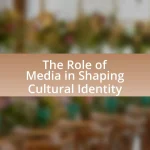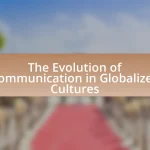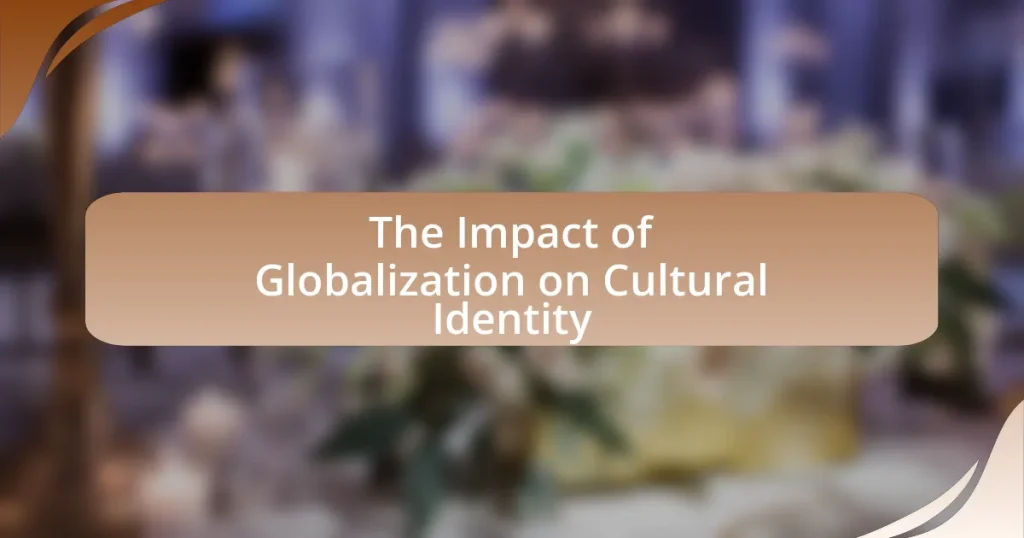The article examines the impact of globalization on cultural identity, highlighting its dual effects of cultural exchange and homogenization. It discusses how globalization facilitates the blending of diverse cultural elements while also posing challenges to the preservation of unique cultural identities. Key factors influencing this dynamic include technological advancements, economic integration, and cultural exchange, which can lead to both the erosion of local traditions and the emergence of hybrid identities. The article emphasizes the importance of maintaining cultural identity in the face of globalization, outlining strategies for individuals and communities to navigate these changes effectively.
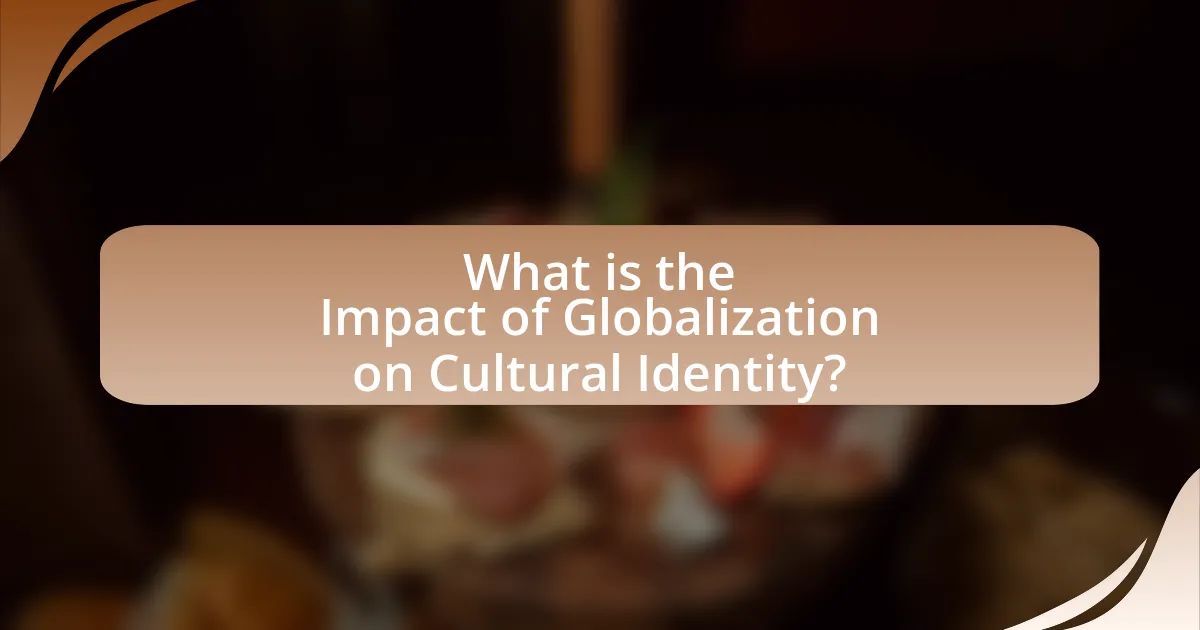
What is the Impact of Globalization on Cultural Identity?
Globalization significantly impacts cultural identity by promoting cultural exchange and homogenization. As global communication and trade increase, diverse cultures interact more frequently, leading to the blending of traditions, languages, and practices. For instance, the widespread adoption of Western media and consumer products can overshadow local cultures, resulting in a loss of unique cultural identities. According to a study by the United Nations Educational, Scientific and Cultural Organization (UNESCO), globalization can lead to cultural erosion, where indigenous cultures struggle to maintain their distinctiveness in the face of dominant global influences. This dynamic illustrates the dual nature of globalization, fostering both cultural diversity and cultural uniformity.
How does globalization influence cultural identity?
Globalization influences cultural identity by facilitating the exchange of ideas, values, and practices across different societies, leading to both cultural homogenization and the emergence of hybrid identities. As global communication and travel increase, individuals are exposed to diverse cultures, which can result in the adoption of foreign customs and lifestyles. For instance, the widespread popularity of Western media and consumer products has led to the integration of Western cultural elements into local traditions, often diluting unique cultural identities. Conversely, globalization also allows for the preservation and revitalization of local cultures through increased visibility and appreciation on a global scale, as seen in the global recognition of indigenous art forms and practices. This dual effect demonstrates that while globalization can challenge traditional cultural identities, it also provides opportunities for cultural exchange and innovation.
What are the key factors of globalization affecting cultural identity?
The key factors of globalization affecting cultural identity include technological advancement, economic integration, and cultural exchange. Technological advancement facilitates instant communication and access to diverse cultures, leading to the blending of cultural practices and values. Economic integration, through trade and investment, promotes the spread of consumer culture, which can overshadow local traditions. Cultural exchange, driven by migration and tourism, allows for the sharing of cultural elements but can also lead to cultural homogenization, where dominant cultures overshadow local identities. These factors collectively influence how individuals and communities perceive and express their cultural identities in a globalized world.
How do cultural exchanges shape identity in a globalized world?
Cultural exchanges shape identity in a globalized world by facilitating the blending of diverse cultural elements, which influences individual and collective identities. Through interactions such as travel, migration, and digital communication, people are exposed to different traditions, languages, and values, leading to a more hybrid identity. For instance, research by the Pew Research Center indicates that 72% of people believe that cultural exchanges enhance their understanding of other cultures, thereby enriching their own identity. This process of cultural assimilation and adaptation allows individuals to incorporate aspects of other cultures into their own, resulting in a more complex and multifaceted identity that reflects global interconnectedness.
Why is cultural identity important in the context of globalization?
Cultural identity is important in the context of globalization because it serves as a foundation for individual and collective self-understanding amidst the rapid changes brought by global interconnectedness. As globalization facilitates the exchange of ideas, goods, and cultures, it can lead to the dilution or loss of local traditions and values. For instance, UNESCO reports that over 40% of the world’s languages are at risk of disappearing, highlighting the threat to cultural diversity. Maintaining cultural identity allows communities to preserve their unique heritage, foster social cohesion, and promote resilience against homogenizing forces. This preservation is crucial for ensuring that diverse perspectives and practices continue to enrich the global landscape.
What role does cultural identity play in individual and community life?
Cultural identity plays a crucial role in shaping individual and community life by providing a sense of belonging and continuity. It influences personal values, behaviors, and social interactions, fostering community cohesion and shared understanding. For instance, research by the Pew Research Center indicates that individuals with a strong cultural identity are more likely to engage in community activities and maintain social networks, which enhances social capital. Additionally, cultural identity can serve as a source of resilience in the face of globalization, allowing communities to preserve traditions and practices that define them, as evidenced by the survival of indigenous cultures despite external pressures.
How does globalization challenge traditional cultural identities?
Globalization challenges traditional cultural identities by promoting a homogenization of cultures, leading to the dilution of unique cultural practices and values. As global communication and trade increase, local customs and traditions often become overshadowed by dominant global cultures, particularly Western influences. For instance, the widespread adoption of Western media, fashion, and consumer products can diminish the visibility and practice of indigenous cultures, as seen in many countries where local languages and traditions are increasingly replaced by English and Western norms. This phenomenon is supported by research from sociologist Arjun Appadurai, who discusses the concept of “ethnoscapes” and how global flows of people and ideas can disrupt local cultural identities.
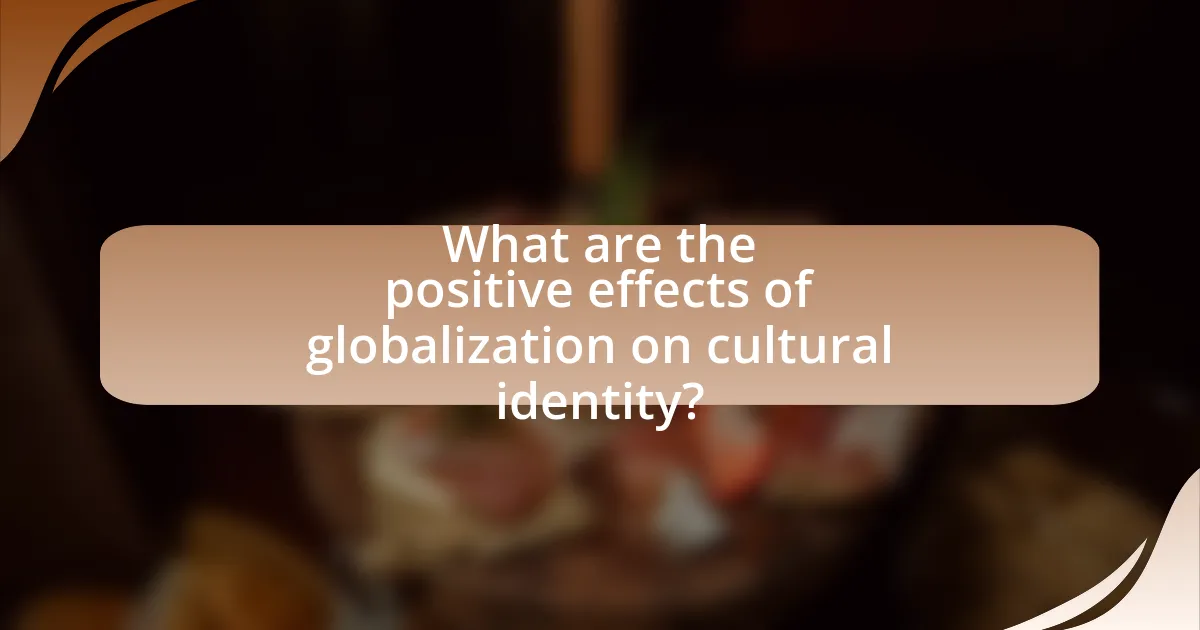
What are the positive effects of globalization on cultural identity?
Globalization positively affects cultural identity by facilitating cultural exchange and promoting diversity. This exchange allows individuals and communities to access a wider array of cultural practices, ideas, and traditions, enriching their own cultural experiences. For instance, the proliferation of global media and communication technologies enables the sharing of cultural narratives, leading to greater awareness and appreciation of different cultures. Research by the Pew Research Center indicates that exposure to diverse cultures can enhance social cohesion and mutual respect among different ethnic groups. Furthermore, globalization encourages the preservation of local cultures as communities adapt and innovate in response to global influences, thereby reinforcing their unique cultural identities while participating in a global context.
How does globalization promote cultural diversity?
Globalization promotes cultural diversity by facilitating the exchange of ideas, traditions, and practices across different societies. This interconnectedness allows for the blending and sharing of cultural elements, leading to a richer tapestry of global culture. For instance, the proliferation of the internet and social media enables individuals from diverse backgrounds to share their cultural expressions, such as music, art, and cuisine, with a global audience. According to a report by UNESCO, cultural diversity is enhanced through the mobility of people and the cross-border flow of cultural goods and services, which fosters mutual understanding and respect among different cultures.
What examples illustrate the blending of cultures through globalization?
Examples that illustrate the blending of cultures through globalization include the fusion of culinary traditions, such as the popularity of sushi burritos, which combine Japanese sushi with Mexican burrito elements. This culinary innovation reflects how global food trends merge distinct cultural practices. Additionally, the rise of K-pop, a South Korean music genre, showcases the integration of Western musical styles with traditional Korean elements, leading to a worldwide fanbase and cultural exchange. Furthermore, fashion brands often incorporate diverse cultural motifs, as seen in the use of African prints by Western designers, promoting cross-cultural appreciation and collaboration. These examples demonstrate how globalization facilitates cultural interactions and the creation of hybrid identities.
How do global platforms support cultural expression?
Global platforms support cultural expression by providing accessible spaces for diverse voices and creative content from around the world. These platforms, such as social media networks and streaming services, enable individuals to share their cultural narratives, art, and traditions with a global audience. For instance, platforms like YouTube and Instagram allow users to showcase local music, dance, and visual arts, fostering cross-cultural exchange. According to a 2021 report by the Pew Research Center, 72% of users believe that social media helps them connect with people from different cultures, highlighting the role of these platforms in promoting cultural diversity and understanding.
In what ways does globalization enhance cultural exchange?
Globalization enhances cultural exchange by facilitating the flow of ideas, traditions, and practices across borders. This process occurs through various channels such as international trade, travel, and digital communication, which allow diverse cultures to interact and influence one another. For instance, the rise of the internet has enabled instant access to cultural content from around the world, leading to the widespread sharing of music, art, and literature. According to a report by the United Nations Educational, Scientific and Cultural Organization (UNESCO), cultural industries have seen significant growth due to globalization, with the global market for cultural goods and services reaching over $2 trillion in 2019. This economic impact underscores how globalization not only promotes cultural exchange but also fosters mutual understanding and appreciation among different societies.
What are the benefits of cross-cultural interactions?
Cross-cultural interactions enhance understanding and appreciation of diverse perspectives, leading to improved communication and collaboration. These interactions foster empathy and reduce stereotypes, as individuals learn about different cultural practices and values. Research indicates that organizations with diverse teams experience increased creativity and innovation, as varied viewpoints contribute to problem-solving. Additionally, cross-cultural interactions can lead to personal growth, as individuals develop adaptability and open-mindedness, essential skills in a globalized world.
How do international collaborations influence cultural identity?
International collaborations significantly influence cultural identity by facilitating the exchange of ideas, practices, and values among diverse cultures. This exchange often leads to the blending of cultural elements, resulting in hybrid identities that reflect both local and global influences. For instance, collaborative projects in art, music, and cuisine can introduce new styles and techniques, reshaping traditional practices. Research by the Pew Research Center indicates that exposure to different cultures through international collaborations can enhance cultural awareness and appreciation, leading to a more interconnected global identity.
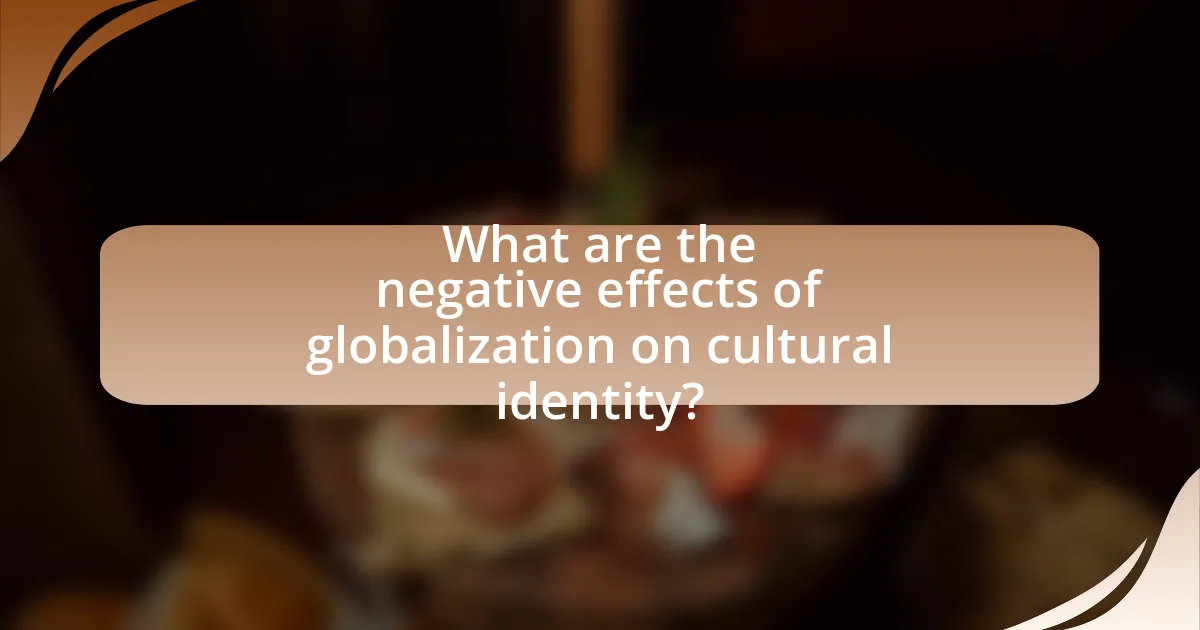
What are the negative effects of globalization on cultural identity?
Globalization negatively affects cultural identity by promoting homogenization, leading to the erosion of unique cultural practices and traditions. As global media and multinational corporations dominate, local customs and languages often diminish, resulting in a loss of cultural diversity. For instance, UNESCO reports that over 40% of the world’s languages are at risk of disappearing, largely due to the influence of dominant cultures. This cultural dilution can create a sense of alienation among individuals who feel disconnected from their heritage, as seen in various communities worldwide where traditional practices are replaced by global consumer culture.
How does globalization lead to cultural homogenization?
Globalization leads to cultural homogenization by facilitating the widespread exchange of ideas, products, and practices across borders, resulting in a convergence of cultural expressions. This process is driven by multinational corporations promoting similar consumer goods and media content worldwide, which diminishes local cultural diversity. For instance, the global dominance of brands like McDonald’s and Coca-Cola exemplifies how local cuisines and traditions can be overshadowed by a uniform global culture. Additionally, the proliferation of the internet and social media allows for the rapid dissemination of cultural trends, further reinforcing a shared global identity at the expense of unique local cultures.
What are the consequences of losing unique cultural traits?
Losing unique cultural traits leads to diminished cultural diversity and identity erosion. This loss can result in homogenization, where distinct cultures become indistinguishable, leading to a lack of representation and voice for minority groups. For instance, UNESCO reports that over 40% of the world’s languages are at risk of disappearing, which directly correlates with the loss of unique cultural practices and knowledge systems tied to those languages. Additionally, the economic implications include a decline in cultural tourism, as unique cultural experiences attract visitors; without them, local economies may suffer. The social consequences involve weakened community bonds and a sense of belonging, as cultural traits often serve as a foundation for group identity and cohesion.
How does the dominance of certain cultures affect local identities?
The dominance of certain cultures significantly erodes local identities by imposing external values, practices, and norms. This cultural hegemony often leads to the marginalization of indigenous traditions and languages, as seen in many post-colonial societies where Western culture has overshadowed local customs. For instance, the widespread adoption of English as a global lingua franca has diminished the use of native languages, resulting in a loss of cultural heritage and identity. Additionally, the prevalence of global media and consumer culture promotes homogenized lifestyles, further diluting unique local practices and beliefs. Studies indicate that communities experiencing cultural dominance often face identity crises, as individuals struggle to reconcile their traditional values with the pressures of globalization.
What challenges do communities face in preserving their cultural identity?
Communities face significant challenges in preserving their cultural identity due to globalization, which often leads to cultural homogenization. This phenomenon occurs as global media and consumer culture promote dominant cultural narratives, overshadowing local traditions and practices. For instance, the widespread influence of Western media can diminish the visibility of indigenous languages and customs, resulting in their gradual erosion. Additionally, economic pressures compel communities to adopt global market practices, further diluting their unique cultural expressions. Research indicates that over 90% of the world’s languages are at risk of disappearing, highlighting the urgency of these challenges.
How do economic pressures impact cultural practices?
Economic pressures significantly influence cultural practices by altering the availability of resources and shaping societal values. For instance, in economically strained environments, communities may prioritize survival over traditional customs, leading to a decline in cultural rituals and practices. A study by the World Bank indicates that economic downturns can result in reduced funding for cultural programs, which diminishes the preservation of cultural heritage. Additionally, globalization often introduces foreign economic models that can overshadow local traditions, as seen in many developing countries where Western consumer culture has replaced indigenous practices. This shift not only affects the expression of cultural identity but also transforms social interactions and community cohesion.
What strategies can communities use to maintain their cultural heritage?
Communities can maintain their cultural heritage through strategies such as education, documentation, and community engagement. Education initiatives, including workshops and cultural programs, help transmit knowledge and traditions to younger generations, ensuring continuity. Documentation of cultural practices, languages, and histories through written records, audio-visual materials, and digital archives preserves these elements for future reference. Community engagement, including festivals and cultural events, fosters a sense of belonging and pride, encouraging participation in cultural practices. These strategies are supported by research indicating that active participation in cultural heritage activities strengthens community identity and resilience against the pressures of globalization.
What can individuals do to navigate the impact of globalization on their cultural identity?
Individuals can navigate the impact of globalization on their cultural identity by actively engaging in cultural preservation and education. This involves participating in local cultural events, learning traditional practices, and promoting the use of native languages. For instance, UNESCO reports that cultural diversity is essential for sustainable development, highlighting the importance of maintaining cultural heritage in the face of globalization. By fostering connections within their communities and sharing their cultural narratives, individuals can strengthen their identity and resist homogenization.
How can one engage with both global and local cultures effectively?
To engage effectively with both global and local cultures, one should actively participate in cultural exchanges and community events while also utilizing digital platforms for broader interaction. Engaging in local festivals, workshops, and discussions fosters a deeper understanding of local customs and traditions, while participating in global forums, online courses, and social media groups allows for exposure to diverse perspectives and practices. Research indicates that individuals who immerse themselves in both local and global cultural experiences develop a more nuanced cultural identity, enhancing their adaptability and empathy in multicultural settings.
What practices can help in preserving cultural identity amidst globalization?
Practices that can help in preserving cultural identity amidst globalization include promoting local languages, supporting traditional arts and crafts, and fostering community engagement in cultural events. Promoting local languages ensures that unique linguistic heritage is maintained, as evidenced by UNESCO’s recognition of language as a key component of cultural identity. Supporting traditional arts and crafts not only sustains local economies but also reinforces cultural narratives, as seen in various artisan cooperatives worldwide. Additionally, fostering community engagement through cultural festivals and educational programs strengthens social ties and enhances awareness of cultural heritage, which is crucial in a globalized context where homogenization threatens diversity.


